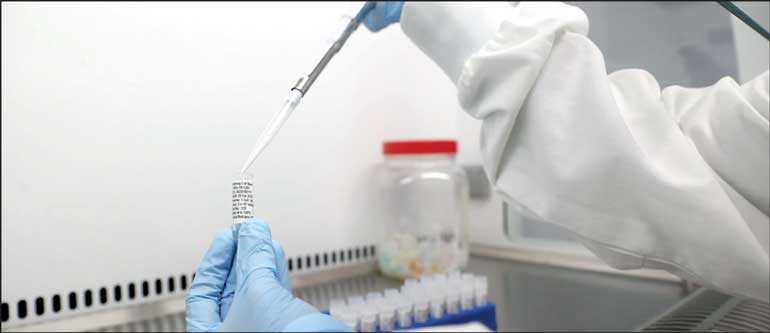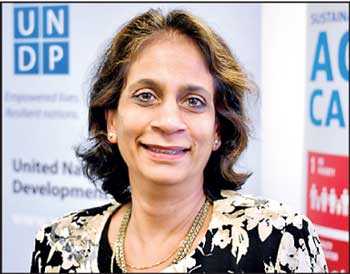Monday Feb 24, 2025
Monday Feb 24, 2025
Saturday, 12 September 2020 00:10 - - {{hitsCtrl.values.hits}}

Scientific knowledge and breakthroughs will underpin our global and regional health response and expand it at a speed and scale we have not seen before
By Kanni Wignaraja
 Since January 2020, scientists have been studying COVID-19 and developing vaccines, and Governments have introduced unprecedented measures to stop its spread. While we knew close to nothing about this coronavirus eight months ago, we now have a clearer idea about what it is, how it strikes and what needs to be done.
Since January 2020, scientists have been studying COVID-19 and developing vaccines, and Governments have introduced unprecedented measures to stop its spread. While we knew close to nothing about this coronavirus eight months ago, we now have a clearer idea about what it is, how it strikes and what needs to be done.
First, on tackling this coronavirus. Scientific knowledge and breakthroughs will underpin our global and regional health response and expand it at a speed and scale we have not seen before. The necessary health response must go beyond current levels of testing, contact tracing and treatment – to reach larger numbers. We hear it repeatedly – “no one is safe until everyone is safe”. This requires planning and investments in health infrastructure to cover not just a ‘last mile’ but many miles.
Our UN maxim, of ‘leaving no one behind’ will be severely tested by the global health effort to get out “the” vaccine. To ensure a fast and fair distribution of the COVID vaccine, as soon as it becomes available (and affordable) at scale, managing a robust vaccine cold chain will be critical. The Government of India and UNDP award-winning program eVin – a smart phone app for tracking availability and safe storing of vaccines – helps to manage vaccine stocks at 27,000 storage centres across India. This type of blending of medical and digital expertise for fast acting solutions will be essential.
There is also another type of bold solution. This is the story of universal healthcare – and we have seen how it has helped keep Thailand in a much better state than many other countries in the region, as this was a wise strategy they had already deployed in 2002.
Second, the state-citizen trust is at a premium during a time of emergence. Real-time public communication – to provide people with warnings of outbreaks, announcing lockdowns, providing factual prevention and care information and staying in regular touch to calm a society’s fears – has been vastly different in countries, and depending on the public outreach, peoples’ trust in their leaders have grown or waned. Vietnam’s timely and direct information campaigns and public engagement has shown the positive power of communication strategy.
Mobile and internet access has been key to making this work. Affordable internet access has also allowed people to continue with their education, to work, receive current information and to stay connected. Our Access to Information a2i partnership with the Government of Bangladesh, which operates 5,000 Digital Centres, provides a connection to those who need to access public services. Yet, this again, is not enough. Affordable internet connectivity must be provided as a universal public good and made available to all.
The rates of internet penetration vary dramatically across Asia and the Pacific, from over 90% in the Republic of Korea to around 30% in Timor Leste. As Governments mobilise trillions of dollars to recover from the pandemic, those with existing or fast-growing investments in internet connectivity are also those transitioning faster to the digital economy. While the direction of travel towards the Fourth Industrial Revolution has been inevitable for some time, COVID-19 has been an accelerant. Robotics, artificial intelligence (AI), quantum computing, the Internet of Things, genetic engineering and other technology-driven ways of working are a part of that ‘next normal’. Recent research indicates that 12% of current jobs across Asian markets could be automated over the next five years, with AI affecting one in five jobs. At the same time, 70% of Asia’s labour force is currently dependent on the informal sector. In order to square this circle, many more people will need digital learning and skills with inexpensive access to the internet in order to grow with this Future of Work and benefit from the expansion in jobs that the Fourth Industrial Revolution will bring, and not be diminished or destroyed by it.
This brings me to the final point, a switch to renewable energy. A vaccine that needs a cold chain needs a sustainable energy source to power it, across all terrains. The future of work, food and health that benefits the most, and keeps both people and the planet healthy, must also be propelled by green energy.
The social and economic case for renewables is clear. Recent auctions and power purchase agreements indicate that solar energy is 20% cheaper than coal. Moreover, investments in renewable energy are now generating three times more jobs than investments in polluting fossil fuels. We are supporting Governments in bringing renewable energy access to some of the most disadvantaged communities in Indonesia, Vanuatu and other countries. We are urging the private sector to invest in renewables as a win-win. Like access to the internet, these efforts must move rapidly to scale, requiring public policy and private sector investments to work together.
‘Scale’ is an often over-used term. What works for one household, a community or country, need not be optimal for another. However, when it comes to digital connectivity and renewable energy, like with a COVID vaccine, what is good for one is good for all 4.3 billion of us in Asia and the Pacific.
(The writer is UN Assistant Secretary-General and UNDP Regional Director for Asia and the Pacific.)
Discover Kapruka, the leading online shopping platform in Sri Lanka, where you can conveniently send Gifts and Flowers to your loved ones for any event including Valentine ’s Day. Explore a wide range of popular Shopping Categories on Kapruka, including Toys, Groceries, Electronics, Birthday Cakes, Fruits, Chocolates, Flower Bouquets, Clothing, Watches, Lingerie, Gift Sets and Jewellery. Also if you’re interested in selling with Kapruka, Partner Central by Kapruka is the best solution to start with. Moreover, through Kapruka Global Shop, you can also enjoy the convenience of purchasing products from renowned platforms like Amazon and eBay and have them delivered to Sri Lanka.
Discover Kapruka, the leading online shopping platform in Sri Lanka, where you can conveniently send Gifts and Flowers to your loved ones for any event including Valentine ’s Day. Explore a wide range of popular Shopping Categories on Kapruka, including Toys, Groceries, Electronics, Birthday Cakes, Fruits, Chocolates, Flower Bouquets, Clothing, Watches, Lingerie, Gift Sets and Jewellery. Also if you’re interested in selling with Kapruka, Partner Central by Kapruka is the best solution to start with. Moreover, through Kapruka Global Shop, you can also enjoy the convenience of purchasing products from renowned platforms like Amazon and eBay and have them delivered to Sri Lanka.